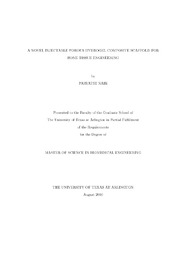
ATTENTION: The works hosted here are being migrated to a new repository that will consolidate resources, improve discoverability, and better show UTA's research impact on the global community. We will update authors as the migration progresses. Please see MavMatrix for more information.
Show simple item record
| dc.contributor.author | Nair, Parvathi | en_US |
| dc.date.accessioned | 2014-03-17T19:46:41Z | |
| dc.date.available | 2014-03-17T19:46:41Z | |
| dc.date.issued | 2014-03-17 | |
| dc.date.submitted | January 2010 | en_US |
| dc.identifier.other | DISS-10808 | en_US |
| dc.identifier.uri | http://hdl.handle.net/10106/24178 | |
| dc.description.abstract | Over the past decade there has been an increasing use of bone grafts for orthopedic applications. With the aging US population, the need for suitable bone grafts substitutes has also increased. The aim of this study was to develop a novel in situ crosslinkable hydrogel composite for tissue-engineering critical-sized bone defects. This system consists of a newly developed water-soluble biodegradable hydrogel Poly ((ethylene glycol) maleate citrate) (PEGMC) and hydroxyapatite (HA). The PEGMC/HA system is completely injectable and can be crosslinked in situ into crosslinked PEGMC/HA (CPEGMC/HA) hydrogel composite with or without poly (ethylene glycol) diacrylate (PEGDA) as a crosslinker. The hydrogel composite was found to have tunable mechanical properties and degradation profile that could be varied by adjusting the HA concentration and polymer compositions. CPEGMC/HA induced rapid and high degree of mineralization when incubated in vitro in simulated body fluid as quantified by SEM/EDX. In hydrated state the composite exhibited highly porous structures with the pore size ranging between 100- 400 &mum. In vitro biocompatibility of the hydrogel composite system was tested against human fetal osteoblast (hFOB1.19). The presence of pendant groups in the hydrogel network as confirmed by FTIR and <super>1</super>H NMR was used to covalently immobilize collagen on the surface to enhance cellular response. Osteoblasts (hFOB 1.19) showed good viability when seeded on the surface or encapsulated inside the polymer network as confirmed by LIVE/DEAD assay. The encapsulation of hFOB 1.19 inside the polymer network promoted cellular proliferation and activity as confirmed by DNA assay and the production of ALP and calcium. In vitro cellular studies show the composites to be a competent potential injectable vehicle for the transport of cells and other biomolecules which can aid in the regeneration of critical sized defects in bone. | en_US |
| dc.description.sponsorship | Yang, Jian | en_US |
| dc.language.iso | en | en_US |
| dc.publisher | Biomedical Engineering | en_US |
| dc.title | A Novel Injectable Porous Hydrogel Composite Scaffold For Bone Tissue Engineering | en_US |
| dc.type | M.S. | en_US |
| dc.contributor.committeeChair | Yang, Jian | en_US |
| dc.degree.department | Biomedical Engineering | en_US |
| dc.degree.discipline | Biomedical Engineering | en_US |
| dc.degree.grantor | University of Texas at Arlington | en_US |
| dc.degree.level | masters | en_US |
| dc.degree.name | M.S. | en_US |
Files in this item
- Name:
- Nair_uta_2502M_10808.pdf
- Size:
- 5.308Mb
- Format:
- PDF
This item appears in the following Collection(s)
Show simple item record


